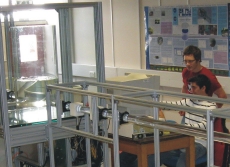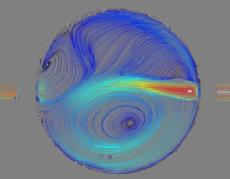Dispersion in manholes experiencing time-varying flows
| Researcher: | Amy Jones |
| Project duration: | 2008-2011 |
| Supervisor: | Prof. Ian Guymer |
| Funding body: | Warwick Postgraduate Research Fellowship |
Project Description
Manholes are generally cylindrical structures with at least one inlet pipe and one outlet. They occur in sewer networks "…at every change of alignment or gradient, at the head of all sewers, at every junction of two or more sewers, wherever there is a change in the size of a sewer and in addition at reasonable intervals for inspection and maintenance." (BSI, 2008). As a result of their frequency and their geometry, they play an important role in the mixing of dissolved pollutants within sewer networks.
Previous research has explored the effect of manhole diameter and water levels (Guymer et al., 2005), the effect of different inlet and outlet pipe levels (Dennis, 2000), the effect of the direction of the inlet and outlet pipe in relation to one another (Saiyudthong, 2003), and the effect of scaling manhole sizes for laboratory studies (Lau, 2008) on mixing across manholes. All of this work, however, has been restricted to constant discharge conditions, which are unlikely to occur often in real sewers due to variation in water use throughout the day and the variation in rainfall intensity during storm events. This project consequently aims to establish how time-varying flows affect solute dispersion within manholes.
A new laboratory-scale manhole model has been constructed in the laboratories at the University of Warwick (Figure 1) to enable this research. Fluorescent dye is injected into the system and the concentration is recorded both upstream and downstream of the manhole under a range of time-varying flow conditions, providing an insight into the mixing occurring. The project aims to find a robust model for mixing in manholes under unsteady conditions.
This work is being undertaken alongside a Computational Fluid Dynamics study by Mr Paul Bennett and Dr Virginia Stovin at the University of Sheffield, which aims to address the same research questions.
The two films on this page (courtesy of Douglas Lau) show Laser-Induced Fluorescence experiments on manhole dispersion under steady flow conditions for low surcharge (left) and high surcharge conditions (right).
|
|
|
References
BSI (2008) BS EN 752: Drain and Sewer Systems Outside Buildings. British Standards Institute, London, UK.
Dennis, P. (2000) Longitudinal Dispersion due to Surcharged Manholes. PhD Thesis, The University of Sheffield, UK.
Guymer, I., Dennis, P., O'Brien, R. and Saiyudthong, C. (2005) Diameter and Surcharge Effects on Solute Transport across Surcharged Manholes. J. Hydraulic Eng., 131(4), 312-321.
Lau, S.-T. D. (2008) Scaling Dispersion Processes in Surcharged Manholes. PhD Thesis, The University of Sheffield, UK.
O'Brien, R. (2000) Dispersion due to Surcharged Manholes. PhD Thesis, The University of Sheffield, UK.
Saiyudthong, C. (2003) Effect of Changes in Pipe Direction Across Surcharged Manholes on Dispersion and Head Loss. PhD Thesis, The University of Sheffield, UK.

Figure 1: Laboratory-scale manhole model at Warwick University.

Figure 2: PIV –The lines show the path of individual particles under low surcharge conditions, with red representing the higher velocities. (Courtesy of Joe Nawasra)
